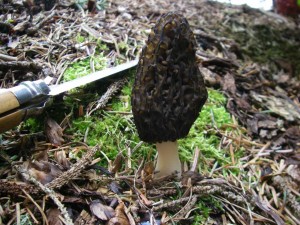Friday, Aly called to tell us she’d landed a prime summer job. While we talked with her with one of our phones set on “speaker,” I sat at my usual place at the dining table, gazing out the window. As I lazily scanned the mounded earth that hosts our rhubarb patch, I spied a small object, which I fancied looked like a morel mushroom.
Since the hummingbirds and songbirds returned to our homestead (see For the Birds) I’ve kept a pair of lower power binoculars handy, to scrutinize the visitors at close range. I grabbed these and examined the thing in the garden, assuming I’d see the details of a newly-emerged rhubarb shoot.
But, no. I saw a morel. An honest-to-goodness morel, a few feet from the cabin door!
Almost all of our edible mushroom varieties appear in midsummer to late autumn (see Gourmet Delicacies for Free: Foraging for Mushrooms), except for one: the morel. This may be the most delectable of our many gourmet-quality wild mushrooms, and must certainly be the rarest. We have found them near us on the peninsula, but those have been lucky finds, with no certainty of finding them in the same place the following year. We’ve discussed driving as far as 30 miles up the river valley to search for them there. But, here’s the very mushroom we seek in our own yard!
An irony of our mushroom foraging continues to be the variety of mushrooms that grow in the compound itself. We see many mushrooms close to the cabin. Almost all of them are either insipid-flavored varieties, unknown to us, or poisonous. Beyond one reliable patch of boletes, and some hawkwings, they’re almost all useless to us as food. Every great now and then we’ll make a discovery. I still fondly recall a single, perfect bolete near the rope swing, totally untouched by insects, late one autumn. Now, here is this one perfect morel.
Sadly, I’ve learned that morel mycilia, the underground fungus of which the mushroom is a fruit, are notably short-lived. Finding morels in a location one year does not guarantee there will be any in the future. I see no evidence that other morels will appear in this same place anytime soon. We’re letting this one grow larger, if it can, guarding it against squirrels. Michelle even watered it the other day.
Certainly, we hope to see more morels in the rhubarb patch or elsewhere. For now, though, just the simple miracle of this one rare morel right here at home, may be enough.

